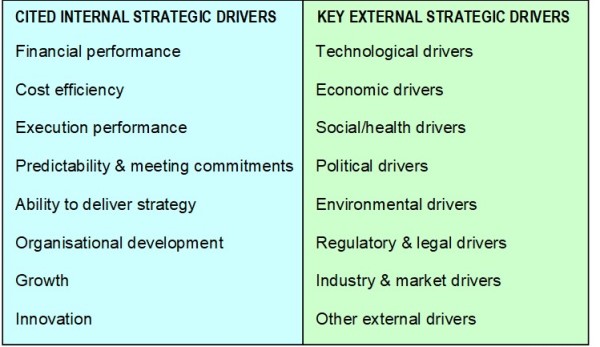into the recursive strategic management model, and discussing differences between industries
Revisiting organisational strategic management
(Part 4)
SERIES ARTICLE
By Alan Stretton, PhD (Hon)
Sydney, Australia
INTRODUCTION
This is the fourth of a series of articles on revisiting organisational strategic management. The first article (Stretton 2020l) proposed a six-stage recursive strategic management sequence, and discussed managerial arrangements to help coordinate and optimise the stages in this model. The second article (Stretton 2020m) discussed augmenting this model to facilitate management of changes impacting planned strategic initiative outcomes and the realisation of benefits. The third article (Stretton 2021a) introduced deliberate and emergent strategies, and assembled and classified a variety of strategic drivers which particularly influence the establishment of strategic objectives.
In this article we will incorporate the internal and external strategic drivers identified above into the recursive strategic management model. We will also discuss some differences between industries in the nature and priorities typically accorded to strategic drivers. We start with the strategic drivers model from Stretton 2021a.
ORGANISATIONAL STRATEGIC DRIVERS MODEL FROM STRETTON 2021a

Figure 4-1: Summary of the main strategic drivers identified in Stretton 2021a
Now, strategic drivers are obviously highly relevant to organisational strategic management. For example, they are at the apex of a “pivot model” of organisational context, strategy and operations used by Fraser 2020, in his Figure 1. So, it appears appropriate to try and illustrate how strategic drivers can be seen to relate to the recursive strategic management model developed in the first article of this series, and further discussed in the second article.
We start with the eight internally-originated strategic drivers in Figure 4-1 above, to which I have added “Other internal drivers”, for obvious reasons.
INCORPORATING INTERNAL STRATEGIC DRIVERS INTO THE RECURSIVE ORGANISATIONAL STRATEGIC MANAGEMENT MODEL
The recursive organisational strategic model I am using is that shown in Figure 1-3 in the first article of this series (Stretton 2020l), which I have here titled “Recursive ongoing strategic management”. The above internal strategic drivers are incorporated internally into this model, as shown in Figure 4-2.
More…
To read entire paper, click here
How to cite this paper: Stretton, A. (2021). Incorporating strategic drivers into the recursive strategic management model, and discussing differences between industries – Revisiting organisational strategic management series (4); PM World Journal, Volume X, Issue III, March. Available online at https://pmworldlibrary.net/wp-content/uploads/2021/03/pmwj103-Mar2021-Stretton-incorporating-strategic-drivers-revisiting-organisational-strategic-management-4.pdf
About the Author

Alan Stretton, PhD
Faculty Corps, University of Management
and Technology, Arlington, VA (USA)
Life Fellow, AIPM (Australia)
![]()
Alan Stretton is one of the pioneers of modern project management. He is currently a member of the Faculty Corps for the University of Management & Technology (UMT), USA. In 2006 he retired from a position as Adjunct Professor of Project Management in the Faculty of Design, Architecture and Building at the University of Technology, Sydney (UTS), Australia, which he joined in 1988 to develop and deliver a Master of Project Management program. Prior to joining UTS, Mr. Stretton worked in the building and construction industries in Australia, New Zealand and the USA for some 38 years, which included the project management of construction, R&D, introduction of information and control systems, internal management education programs and organizational change projects. He has degrees in Civil Engineering (BE, Tasmania) and Mathematics (MA, Oxford), and an honorary PhD in strategy, programme and project management (ESC, Lille, France). Alan was Chairman of the Standards (PMBOK) Committee of the Project Management Institute (PMI®) from late 1989 to early 1992. He held a similar position with the Australian Institute of Project Management (AIPM), and was elected a Life Fellow of AIPM in 1996. He was a member of the Core Working Group in the development of the Australian National Competency Standards for Project Management. He has published over 200 professional articles and papers. Alan can be contacted at alanailene@bigpond.com.au.
To see more works by Alan Stretton, visit his author showcase in the PM World Library at http://pmworldlibrary.net/authors/alan-stretton/.









